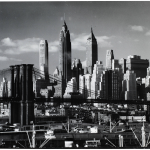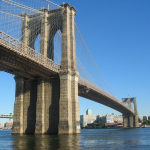The Brooklyn Bridge stands as an enduring symbol of New York City, revered not only for its picturesque views but also for its rich history and engineering marvels. Completed in 1883, it is among the most famous bridges globally, attracting millions of visitors who marvel at its iconic stature. As a testament to ingenuity, the Brooklyn Bridge harmoniously combines Gothic architecture with modern technology, creating a stunning interaction between the old and the new. Its significance stretches beyond mere transportation, embedding itself in the fabric of New York landmarks and representing the profound human desire to connect across distances. With each step across its majestic span, one can appreciate the story it tells—a monument to creativity and resilience that has stood the test of time in a rapidly evolving cityscape.
Dubbed one of the most significant achievements in civil engineering, the Brooklyn Bridge offers a captivating glimpse into a bygone era while facilitating modern connectivity. As a marvel of structural design, it exemplifies the grandeur of iconic constructions that define city skylines around the world. Built over a century ago, it serves as a crucial link between Brooklyn and Manhattan, hosting countless memories for those who traverse its pathways. This celebrated structure is not just a bridge; it stands as a representation of ambition and progress, reflecting the spirit of a nation eager to expand and innovate. With its towering presence and artistic design, the Brooklyn Bridge continues to inspire awe and admiration among locals and tourists alike.
The Rich History of the Brooklyn Bridge
The Brooklyn Bridge, which opened on May 24, 1883, stands as a testament to human ingenuity and vision. This iconic structure was designed by John Augustus Roebling, who envisioned not just a means to connect Brooklyn and Manhattan but a new chapter in the story of urban life in New York. As one of the oldest suspension bridges in the United States, it has witnessed the transformation of New York City from a small port to a bustling metropolis. The bridge has become a symbol of aspiration and resilience, connecting two distinct boroughs with its grand neo-Gothic towers soaring high above the East River.
Over the years, the Brooklyn Bridge has garnered attention not only for its functional role in transportation but also for its artistic and architectural significance. Its intricate design, featuring limestone and granite materials, orchestrates a dialogue between the past and the present. The bridge’s Gothic arches mirror the majesty of ancient cathedrals, while its sturdy cables reflect modern engineering marvels. This blend of styles contributes to the bridge’s status as one of New York’s most treasured landmarks, allowing it to resonate in the hearts of locals and tourists alike.
Brooklyn Bridge: An Engineering Marvel
Celebrated for its innovative engineering, the Brooklyn Bridge was a groundbreaking project of its time. When it was completed, it was the longest suspension bridge in the world, spanning 1,834 feet. The bridge’s design incorporated cutting-edge technology, including the use of steel cables that were both resilient and lightweight. Roebling’s revolutionary thinking allowed the bridge to withstand the forces of nature while accommodating heavy vehicular and pedestrian traffic. This engineering marvel has inspired countless projects throughout the years, shaping the development of future bridges across the globe.
Beyond its structural excellence, the Brooklyn Bridge also embodies the spirit of New York City. It serves as a crucial link between two of the city’s most vibrant areas, facilitating economic and social exchanges that have contributed to the city’s growth. The bridge’s design has influenced a number of famous bridges worldwide, making it a reference point for subsequent engineering feats and solidifying its status as a pivotal chapter in the history of bridge construction.
Iconic Structures: The Legacy of Famous Bridges
Famous bridges like the Golden Gate Bridge and the Sydney Harbour Bridge have captivated onlookers for generations, much like the Brooklyn Bridge. These structures serve not just a utilitarian function but also a cultural one, becoming symbols of their respective cities. The Brooklyn Bridge, in particular, is an iconic emblem of New York, recognized for its breathtaking views and architectural grandeur. As a favorite among photographers and artists, it transcends its role as a mere pathway, becoming a canvas that reflects the beauty of urban life and the collective memory of its inhabitants.
Bridges also have an uncanny ability to bring people together, bridging distances — both physical and emotional. Events like marriage proposals or family gatherings along iconic spans like the Brooklyn Bridge have created lasting memories. This emotional significance adds to their allure, creating connections that go beyond the physical structure. The stories behind such encounters contribute to the legacy of these famous bridges, intertwining personal narratives with architectural history.
Exploring Engineering Design: The Art Behind Bridges
The art of bridge design lies in balancing function with aesthetic appeal. For example, the Brooklyn Bridge’s elegant arches and intricate cables are not just supportive elements but are intentional artistic choices that enhance its silhouette against the New York skyline. This interplay between utility and beauty challenges the perception of engineering as a purely technical discipline, inviting a greater appreciation for the creativity involved in bridge construction. Each element of the design contributes to the bridge’s narrative, telling a story of both engineering prowess and artistic vision.
When examining other engineering marvels, one can see similar trends; structures like the Tower Bridge in London or the Millau Viaduct in France exemplify this blend of art and functionality. These iconic structures do not merely exist to serve transportation needs but stand as monuments embodying humanity’s creativity and resilience. In fields of engineering and architecture, the most celebrated designs are those that have transcended their practical purposes to become integral components of the cultural and historical fabric of their locales.
Brooklyn Bridge: A Cultural Icon
As a cultural icon, the Brooklyn Bridge captures the essence of New York City. Its image graces countless postcards, films, and artworks, establishing it as a beacon of American ingenuity and resilience. From its early days to modern times, the bridge has served as a gathering place for celebrations, protests, and artistic expressions. It has become a stage for the diverse narratives that embody the spirit of the city, making it a cherished destination for locals and visitors alike.
The bridge’s presence in movies and literature further solidifies its role as a cultural symbol. It serves as a backdrop for stories of love, loss, and triumph, each narrative contributing to its rich tapestry of meaning. Traveling across the Brooklyn Bridge is not merely a journey from one borough to another; it is an experience that connects individuals to the collective history of New York. This deep connection between the bridge and the cultural identity of the city makes it a defining feature of the landscape, one that continues to resonate through generations.
The Visionary Behind the Brooklyn Bridge
John Augustus Roebling’s vision for the Brooklyn Bridge was rooted in his understanding of both functionality and artistry. A pioneer in bridge engineering, he sought to create a structure that was not only durable but also aesthetically pleasing. Roebling’s ability to envision a bridge as a work of art set the stage for its eventual legacy. His incorporation of graceful Gothic arches into the design conveys elegance while ensuring structural integrity, showcasing the beauty of engineering and the importance of artistic influence in such monumental projects.
Sadly, Roebling did not live to see his masterpiece completed, but his legacy endures through the bridge’s existence. His son, Washington Roebling, carried forth his father’s pioneering spirit, overcoming significant challenges to ensure the bridge’s completion. This familial dedication and vision reflect the passionate resolve that birthed the Brooklyn Bridge, symbolizing not only an engineering triumph but also an inspiring narrative of perseverance and ambition.
Visiting the Brooklyn Bridge: A Must-See Attraction
Visiting the Brooklyn Bridge offers an unparalleled view of the New York skyline, making it a top attraction for tourists and locals alike. The serene pedestrian walkway allows visitors to leisurely stroll while taking in the vast expanses of the East River, along with sweeping views of Lower Manhattan and Brooklyn. Each visit provides a unique experience, as the bridge dynamically interacts with changing weather conditions and time of day, transforming its facade from sublime to dramatic.
Moreover, the Brooklyn Bridge is a gateway to experiencing the adjacent neighborhoods of Dumbo and Brooklyn Heights, which offer charming shops, parks, and restaurants. These areas enrich the visitor experience, inviting one to explore the lively culture that thrives in the shadow of this famous structure. Complementing its architectural splendor with the vibrancy of the surrounding community provides a holistic view of what makes the Brooklyn Bridge a pillar of New York’s identity.
The Environmental Impact of the Brooklyn Bridge
As an iconic structure, the Brooklyn Bridge represents not just a pathway but also a consideration of environmental impact. Built over a century ago, it highlights the need for sustainable design practices, especially in urban infrastructure. The bridge’s historic status encourages modern engineers and architects to incorporate eco-friendly technologies and materials in other projects, demonstrating that historical masterpieces can inspire forward-thinking solutions.
Furthermore, the Brooklyn Bridge serves as a reminder of the importance of preserving iconic structures. As New York evolves, urban planning must consider how to maintain such landmarks without compromising their structural integrity or historical value. Engaging with sustainability practices ensures that future generations will continue to enjoy the bridge, bolstering its role as a symbol of connectivity and progress in the urban environment.
Photographic Artistry and the Brooklyn Bridge
The Brooklyn Bridge has inspired photographers for decades, capturing its elegance and grandeur in varying light and seasons. One such artist, Andreas Feininger, was renowned for his photographic explorations that highlighted the bridge’s architectural beauty and its connection to the city. His works not only convey the visual splendor of the bridge but also evoke emotional responses, allowing viewers to connect with the shared experience of traversing this iconic structure.
Photography, as a medium, has played a crucial role in cementing the Brooklyn Bridge’s status as an icon. By immortalizing its beauty, photographers have helped convey the bridge’s significance in popular culture. Images of the bridge have appeared in countless publications, further embedding it in the consciousness of people around the world and fueling admiration for this extraordinary engineering feat.
Frequently Asked Questions
What is the history of the Brooklyn Bridge?
The Brooklyn Bridge, an iconic structure completed in 1883, connects Brooklyn and Manhattan in New York City. Designed by John Augustus Roebling, this engineering marvel was the first steel-wire suspension bridge and became a symbol of innovation and American ambition during the industrial era. Its unique neo-Gothic design combined functionality with aesthetic appeal, making it one of the most famous bridges in the world.
Why is the Brooklyn Bridge considered an engineering marvel?
The Brooklyn Bridge is considered an engineering marvel for its groundbreaking use of steel wire for its cables and its impressive span of 1,834 meters. At the time of its completion, it was the longest suspension bridge in the world, showcasing advanced architectural techniques. The bridge’s combination of strength, stability, and aesthetic design, especially with its iconic Gothic arches, exemplifies Roebling’s visionary engineering skills.
What makes the Brooklyn Bridge an iconic structure?
The Brooklyn Bridge is an iconic structure due to its stunning architectural design, historical significance, and its representation of New York City’s spirit. It combines gothic elements with modern engineering to create a visually stunning silhouette against the Manhattan skyline. As a symbol of connection and perseverance, it attracts millions of visitors each year who come to admire its beauty and historical importance.
How does the Brooklyn Bridge compare to other famous bridges?
The Brooklyn Bridge stands out among other famous bridges like the Golden Gate Bridge and London’s Tower Bridge due to its architectural innovation and historical context. While the Golden Gate Bridge is known for its Art Deco design and stunning location, and Tower Bridge showcases Victorian Gothic style, the Brooklyn Bridge combines both engineering prowess and striking aesthetics, making it a timeless masterpiece and a must-visit New York landmark.
What are the key features of the Brooklyn Bridge?
Key features of the Brooklyn Bridge include its two majestic towers, which rise 270 feet over the East River, the intricate Gothic arches that add to its allure, and the network of steel cables that support its span. Its pedestrian walkway, allowing thousands to traverse between Manhattan and Brooklyn, showcases the bridge’s commitment to connecting communities while offering breathtaking views of the New York City skyline.
Can you walk across the Brooklyn Bridge, and what can you see?
Yes, you can walk across the Brooklyn Bridge, and the experience is renowned for its stunning views. As you stroll along the nearly mile-long walkway, you can see panoramic vistas of the Manhattan skyline, the Statue of Liberty, and the East River. The combination of the bridge’s architectural beauty and the surrounding sights creates a memorable experience for visitors.
What was the inspiration behind the design of the Brooklyn Bridge?
The design of the Brooklyn Bridge was inspired by John Augustus Roebling’s vision to create a lasting symbol of connection and innovation. He fused modern engineering techniques with classical architectural aesthetics, exemplified by the Gothic arches in the towers. This combination not only provided structural stability but also infused the bridge with a sense of grace and nobility, aimed to inspire generations to come.
When was the Brooklyn Bridge opened and what significance does its anniversary hold?
The Brooklyn Bridge was officially opened on May 24, 1883. Each anniversary marks a celebration of its historical and architectural achievements as one of the first steel suspension bridges in the world. This milestone is a reminder of the vision, perseverance, and engineering skill that went into constructing this iconic New York landmark, which continues to captivate millions today.
How has the Brooklyn Bridge remained significant over time?
The Brooklyn Bridge has remained significant over time due to its continuous cultural, historical, and architectural relevance. Despite the evolution of New York City’s skyline and advances in engineering, the bridge has not lost its monumental status. It serves as a vital transportation link, a popular tourist destination, and a symbol of resilience and community, reflecting the human spirit of connection across time.
What artistic representations exist of the Brooklyn Bridge?
The Brooklyn Bridge has been a subject of numerous artistic representations, particularly in photography, painting, and literature. Iconic photographers like Andreas Feininger captured its beauty in various conditions, while artists showcased its grandeur in countless artworks. These representations underline the bridge’s significance as both an engineering feat and a source of inspiration, celebrating its role as a beloved New York landmark.
| Key Point | Details |
|---|---|
| Idea of a Bridge | A bridge starts as an idea, and if strong enough, it manifests into a lasting structure. |
| Bridges as Connections | Bridges symbolize humanity’s need to connect with people and places. |
| Famous Bridges | Examples like the Golden Gate, Ponte dei Sospiri, and Tower Bridge show the diverse beauty of bridges. |
| Brooklyn Bridge Significance | Opened in 1883, it connects Brooklyn and Manhattan and showcases neo-Gothic architecture. |
| Architectural Vision | Designed by John Augustus Roebling, it combines strength and beauty with Gothic elements. |
| Continuous Relevance | Despite changes in its surroundings, the Brooklyn Bridge remains a monumental symbol. |
Summary
The Brooklyn Bridge stands as an iconic symbol of engineering and artistry that has unified Brooklyn and Manhattan for 130 years. Since its opening on May 24, 1883, this neo-Gothic marvel has not only facilitated transportation but has also celebrated human connections. Reflecting both historical grandeur and modern vibrancy, the bridge showcases the genius of its designer, John Augustus Roebling, merging innovative structural design with aesthetic elegance. In a city that continually evolves, the Brooklyn Bridge retains its monumental status, becoming an enduring testament to visionary engineering and the rich narrative of connectivity it embodies.





